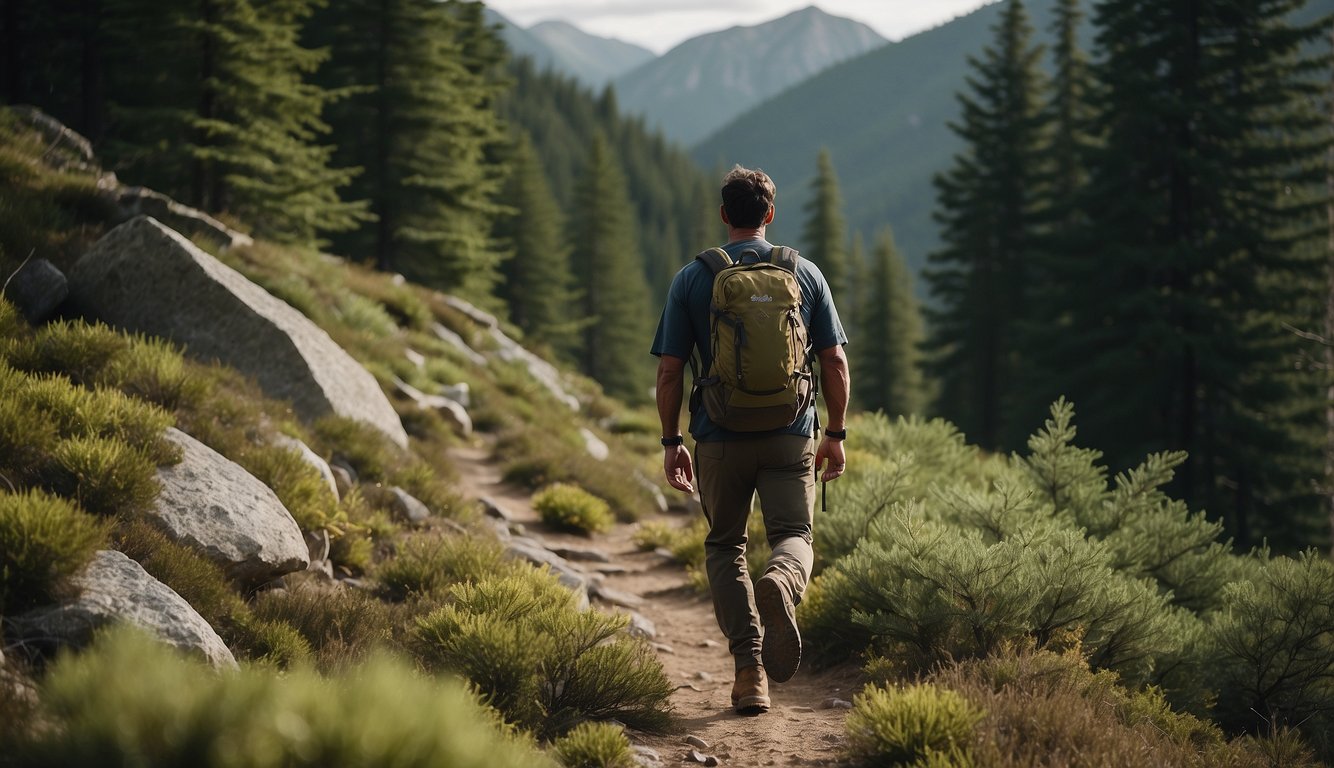How To Cope With Fear and Anxiety While Trail Running (Related to Isolation or Injury)
As a UESCA certified running coach, I’ve seen firsthand how the combination of isolation and the potential for injury can contribute to anxiety and fear on the trails. I understand that staying mentally resilient is just as important as physical preparation in these environments. The stillness of a solo run can amplify our inner worries, but with the right strategies, you can transform solitude into an empowering experience.
When you’re miles away from the nearest person, fears over what could go wrong—like an unexpected injury—can become overwhelming. It’s essential to acknowledge these feelings as a natural response to perceived threats. However, by equipping yourself with a clear action plan to manage both isolation and injury-related anxiety, you can enhance your mental health while enjoying the solitude of the trails.
Remember, coping starts with recognizing the signs of anxiety and then implementing measures to address it directly. Always prepare for your runs by informing someone about your route and expected return, carry a basic first aid kit, and familiarize yourself with the trails. With these precautions in place, you can focus on the run, confident in your ability to handle whatever comes your way.
Understanding Anxiety and Fear in Isolation

In my experience as a coach, it’s important to recognize that isolation, particularly on the trails, can trigger both anxiety and fear. These emotions are natural, yet understanding them is the first step towards managing and overcoming them.
The Different Types of Isolation
Isolation takes many forms, but when it comes to trails, the most common types are:
- Intrapersonal Isolation: This involves a disconnect with oneself and can be exacerbated by long periods alone on the trails, leading to heightened self-criticism or doubt.
- Interpersonal Isolation: Being physically distant from others, which during a run can lead to feelings of loneliness or vulnerability.
- Existential Isolation: Stemming from existential theory, this refers to the fundamental gap in connecting with others, a profound sense of separateness that can peak during a solitary run.
Each type can contribute to stress and anxiety disorders, influencing our mental health.

Psychological Effects of Solitude
While solitude has the potential for positive self-reflection, it can also lead to a range of psychological effects:
- Loneliness: Feelings of being disconnected from the social world.
- Symptoms of Mental Health Disorders: Including signs of depression and anxiety, such as restlessness, a feeling of dread, or uncontrollable worry.
- Stress: A response to the pressure of isolation which can manifest in both physical and psychological ways.
Especially during the pandemic, the connection between isolation and mental health became clear as many individuals faced these challenges. Understanding the psychological impact of solitude is crucial to managing anxiety and fear related to isolation on the trails.
Identifying Signs and Symptoms

When tackling challenges on the trails, it’s vital to recognize the signs of anxiety and fear that can arise from isolation or the potential for injury. Understanding these can empower you to manage them effectively.
Recognizing Anxiety and Fear
I’ve seen many runners confuse the occasional nervousness with anxiety. Anxiety on the trails often manifests when thinking obsessively about potential danger or worrying about getting injured or lost. Fear is a natural response but should not be paralyzing. An unexpected sound or the deep silence of a less-traveled path might trigger it.
Physical and Mental Indicators
Physical Symptoms:
- Increased heart rate & sweating: Stress response can spike your heart rate, accompanied by perspiration even in cool weather.
- Trembling: Anxiety may cause shaking or trembling, often linked to adrenaline.
- Hyperventilation: Breathing may become rapid, leading to dizziness or lightheadedness.
Mental and Emotional Symptoms:
- Loneliness or depression: These can emerge due to prolonged isolation and the daunting nature of the trail.
- Stress: It’s the body’s reaction to any change that requires an adjustment or response and can affect mental well-being.
- Panic: The intense fear that might include a fear of disaster or losing control even when there is no real danger.
Becoming aware of these indicators is the first step in taking control of your trail running experience.
Effective Coping Mechanisms

When tackling fear on the trails, strategic coping mechanisms can make a significant difference. I focus on developing supportive routines and relaxation practices which have proven effective in managing anxiety related to isolation or injury.
Building a Supportive Routine
Creating a supportive routine is vital for maintaining mental stability and reducing anxiety. Exercise plays a crucial role, given its stress-reducing properties.
I recommend incorporating activities such as running or hiking on a regular basis. Consistency is key, so aim to exercise most days of the week. Here’s an example of a weekly exercise plan that can help:
| Day | Activity |
|---|---|
| Monday | Trail Run – 30 mins |
| Tuesday | Rest or Gentle Yoga |
| Wednesday | Short Hike – 1 hour |
| Thursday | Rest or Strength Training |
| Friday | Trail Run – 45 mins |
| Saturday | Long Walk or Hike |
| Sunday | Rest or Mindfulness Session |
Sleep and diet are also foundational to a supportive routine. A balanced diet rich in vegetables, fruits, whole grains, and fish can promote mental well-being. For sleep, establishing a regular schedule and creating a restful environment are crucial steps.
Engagement in Relaxation Practices
Incorporating relaxation practices can greatly alleviate stress and anxiety. Meditation, yoga, and mindfulness are techniques I often turn to for immediate relief.
They help to focus the mind and soothe the nervous system. I also practice journaling to manage overwhelming thoughts. Here’s a quick guide to relaxation practices:
- Meditation: Start with as little as 5 minutes a day and focus on your breath.
- Yoga: Join a class or follow an online session to combine physical movement with breath work.
- Mindfulness: Engage in activities with full attention and practice mindfulness during routine tasks.
- Journaling: Dedicate time each day to write down your thoughts to clear your mind.
Engaging in these practices can empower you to manage the psychological challenges that come with spending time alone on the trails or dealing with potential injuries. Remember, reaching out to a mental health professional is a strong and proactive step if you find these strategies aren’t enough.
Overcoming Injury-Related Anxiety

Facing injury-related anxiety requires both proactive and reactive strategies. The key to managing this anxiety is through preventive measures to minimize the risk of injury and psychological techniques to manage anxiety when injured.
Preventive Measures and Preparedness
I emphasize the importance of preventive measures for my clients. Injury isn’t just painful physically; it mentally induces fear and anxiety around the anticipated dangers of isolation or reinjury. To address this, I advise a two-fold approach focused on function and mechanism of injury:
- Strength Training: Incorporate exercises that target stability and core strength, decreasing the chance of a trail-running injury.
- Technique: Refine running technique to ensure efficiency and safety.
By instilling safety as a key component of a runner’s regimen, the fear of injury can be significantly reduced.
Managing Immediate Anxiety During Injury
Despite all efforts, injuries can occur, and it is vital to manage the stress and anxiety that can arise during these moments. Here’s how to handle immediate injury on the trails:
- Remain Calm: Stress management starts with deep breathing to maintain a clear head.
- Assessment: Quickly assess your injury to determine if you need emergency response or if it’s something manageable with your first aid.
Taking control of the situation helps reduce fear and anxiety levels. Remember, seeking help is a strength, not a weakness, when injuries escape the scope of self-care.
Leveraging Professional Help and Resources

In my experience as a coach, I’ve seen how crucial it is for trail runners to know when and how to seek professional mental health support, especially when dealing with anxiety related to isolation or the prospect of injury.
When to Consult a Mental Health Professional
I advise runners to consider professional help if persistent feelings of stress, anxiety, or doom start to interfere with daily functioning or trail-running enjoyment. It’s essential to recognize that feeling helpless isn’t a sign of weakness; it’s a signal to seek assistance. Here are indicators for when to seek help:
- Persistent Anxiety: You worry excessively about potential injuries or feel extreme fear of isolation on long runs, despite precautions.
- Intense Stress: The thought of running alone or injury risks induces stress that hampers your everyday activities.
- Mood Changes: Sudden mood swings or feelings of sadness that impact your training or personal life warrant professional input.
Exploring Medication and Therapy Options
Medication and therapy are two resources for treating anxiety that can be tailored to individual needs. Medications, when prescribed by healthcare professionals, can alleviate symptoms of anxiety and allow you to focus on your love for the trails.
Psychotherapy, including cognitive-behavioral therapy, helps reframe negative thoughts. Here’s a quick guide:
| Treatment Option | Description | Considerations |
|---|---|---|
| Medications (Anxiolytics) | Prescribed drugs, such as SSRIs, to balance brain chemicals and manage anxiety symptoms. | Side effects, interaction with other medications |
| Cognitive Behavioral Therapy | A therapy focusing on changing negative thought patterns associated with isolation or injury-related fear. | Finding a therapist who specializes in anxiety disorders |
Always consult qualified healthcare professionals for a precise diagnosis and to discuss the best treatment plan for your situation. Remember, taking care of your mental health is just as important as physical training for running the trails.
Maintaining Long-Term Mental Wellness

Maintaining mental wellness is critical for trail runners, especially when facing the challenges of isolation or injury. It’s essential to incorporate lifestyle changes and to build resilience, ensuring a strong psychological foundation for future stresses.
Incorporating Lifestyle Changes
I understand the importance of establishing a routine. A structured day can provide balance and help maintain both mental health and physical well-being. Below is a simplified weekly routine that can incorporate healthy habits for different age groups:
Monday to Friday
- Adults: 30 minutes of cardiorespiratory fitness training in the morning.
- Children: Outdoor activities after school to promote community engagement.
- Elderly: Light walking or balance exercises to stay active.
Weekends
- All ages: Participate in a local hiking or walking group to build community ties and remain socially active.
It’s also vital to combat the stigma around mental health. Open discussions in schools and workplaces can encourage the general population to seek help and support when needed.
Staying productive can also alleviate some psychological impact associated with trail anxiety, such as complications from weight gain or morbidity associated with sedentary behavior.
Building Resilience Against Future Stress
Resilience is built through consistent practice and facing challenges head-on. Here’s a strategy that can help individuals become more resilient against the stress of potential isolation or injury on the trails:
Daily Resilience-Building Activities:
- Mornings: Spend 10 minutes meditating to clear the mind for the day ahead.
- During Work/School: Take short, active breaks every hour to fight off pressure and fatigue.
- Evenings: Reflect on the day’s events and write down lessons learned or moments of gratitude.
Understanding potential comorbidities, like the relationship between mental health issues and physical injuries, allows for a more holistic approach to prevention and recovery.
By integrating these strategic changes into daily life and seeking support from others when needed, long-term mental wellness becomes an achievable goal for trail runners and outdoor enthusiasts alike.
